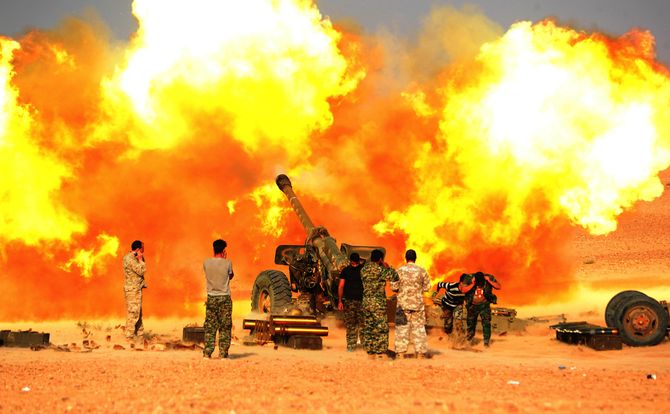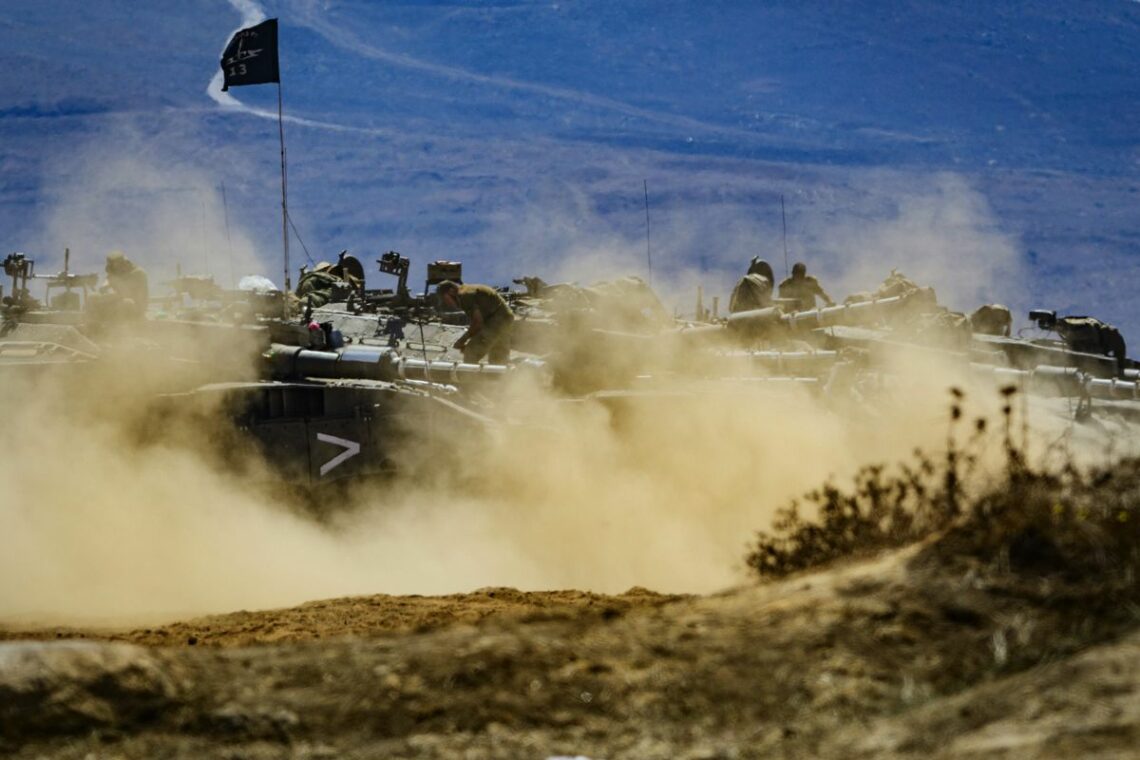2018 Global Outlook: Four dangerous dynamics in the Middle East
Early 2018 finds the Middle East at a singular moment in its history. It is hard to recall a period when so many fundamental geopolitical shifts have occurred just as societies, states and alliances in the region were all starting to fall apart.

In a nutshell
- Iran’s strategic victory in Syria sets up a possible confrontation with Israel
- Spillover to Iraq is possible given Arab nationalist resentment at Iranian influence
- At this tense juncture, Saudi Arabia is embarking on risky domestic reforms
- Avoiding war may depend on mediation by a resurgent Russia and the U.S.
Early 2018 finds the Middle East at a singular moment in its history. It is hard to recall a period when so many fundamental geopolitical shifts have occurred just as societies, states and alliances in the region were all starting to fall apart.
Four disruptive trends can be identified, any one of which would have sufficed to cause upheaval and regional instability in the not-too-distant past. These include Iran’s expansion into Syria and Lebanon, making it a de facto military neighbor of Israel; an emerging confrontation between Iraqi nationalists and Iranian-backed Shia militias; Saudi Arabia’s increasing domestic instability; and Russia’s overarching regional presence and influence.
Combined, these developments create a formidable dynamic for armed conflict, especially at a time when regional political and security structures are crumbling and new, transactional alliances are emerging – even among countries of the region that were once former enemies.
Iran and Israel
The first dynamic is focused on a triangle-shaped space south of Damascus, where Iran has been bolstering its military presence near the Golan Heights. It has also been constructing permanent bases in various locations. These bases are nearing completion and it is only a matter of time before they become operational. Israel is understandably very concerned about having Iranian troops close to its borders, threatening the tense peace that has prevailed on the Israeli-Syrian front since the October War of 1973.
One should not underestimate Tehran’s feeling of triumph after the Syrian campaign. Against the odds, Iran defeated not only Daesh, various militias allied with al-Qaeda, and the secular Free Syrian Army, but also a broad Sunni coalition (including Saudi Arabia and Turkey) that provided direct and indirect support for these formations. The ground forces that won this battle were mainly provided by Iran and its proxy militias, especially Hezbollah. Russia confined itself largely to the air campaign.
For Israel, the prospect of Iranian troops on the Golan front may prove to be a threat too many.
This victory – and a sustained ground presence in Syria and Lebanon – would not be possible without Iran’s success in creating and protecting a logistics route stretching from Iran, through Iraq and Syria, to Lebanon. In effect, Tehran now controls an overland corridor from Afghanistan to the Mediterranean. This impressive achievement poses a direct threat to Iran’s regional rivals. It ensures a constant flow of Iranian materiel and weapons – including advanced missiles – to its expeditionary forces and allies.
For Israel, which must already reckon with thousands of Hezbollah rockets in southern Lebanon trained on its cities, the prospect of Iranian troops on the Golan front may prove to be a threat too many. Given Israel’s strategic capabilities, it should not be assumed that an armed conflict in southern Lebanon and the Golan Heights region would remain local in scope. The Israelis could act against Iran even from the waters of the Gulf, through use of submarine-launched cruise missiles. A conflict of this magnitude would be something very new to the Middle East.
Iraqi cauldron
The second dangerous dynamic emerged from September’s independence referendum in Iraqi Kurdistan. In the ensuing confrontation between the central government in Baghdad and the Kurdistan Regional Government (KRG), an important role was played by the Iranian-backed Popular Mobilization Forces (PMF), a 60,000-strong Iraqi Shia militia that helped retake the oil-rich, disputed city of Kirkuk from the Kurdish Peshmerga.
The seizure of the city was reportedly negotiated between General Qassem Soleimani, commander of the Iranian Revolutionary Guard Corps’ elite Quds Force unit, and the Iran-friendly Talabani clan, which leads the main opposition party, the Patriotic Union of Kurdistan (PUK). The effect of this deal was to create a land corridor linking Kirkuk directly to Iran through the Kurdish city of Sulaymaniyah, a PUK stronghold. This gave Tehran both a geostrategic advantage and a handsome reward of oil.
The Popular Mobilization Forces are the key to achieving Iranian objectives in Iraq.
The PMF is key to achieving these and other Iranian objectives in Iraq, such as dominating the political landscape the way it did through Hezbollah in Lebanon. To this end, the PMF is now waging a campaign to participate, with its political wing, in the May parliamentary elections. But this situation also poses the danger of overreach, as control of Kirkuk and the prospect of the PMF becoming Iraq’s Hezbollah, holding near absolute political control backed by the force of arms, may be too much for the United States to accept.
Iranian President Hassan Rouhani has boasted that his country now controls four Arab capitals: Baghdad, Beirut, Damascus and Sana’a. Iraqi Prime Minister Haider al-Abadi has been trying to mitigate the risks of confrontation between Iraqi Arab nationalists of all sects and the Iranian-backed Shia sectarian forces. It is important to keep in mind that Iraqi Shias are Arabs and not Persian, and that the school of Najaf in Iraq – the apex of Shia theology globally – totally rejects the core Iranian doctrine of the supreme leader.
Iraqis of all sects have been demonstrating with slogans such as “Iran – Out! Out! Out!” – unthinkable even a couple of years ago. Mr. Abadi’s hard line on enforcing the constitution against the Kurdish Peshmerga will only succeed if he acts evenhandedly by imposing its provisions on all militias, including the PMF. Iraq’s current prime minister has distanced himself from the sectarianism of his predecessor, Nouri al-Maliki (2006-2014), as shown by two recent visits to Saudi Arabia, Iran’s Sunni archrival. This diplomatic opening has already led to economic agreements and the first direct flights between Riyadh and Baghdad since the 1990 Gulf War.
How Iran reacts to these attempts to curb its influence and developments in Iraqi politics will help shape a potential confrontation in Iraq, especially if the U.S. feels obliged to protect its interests.

Ankara’s reach
Turkey is the one regional power that seems to view its very considerable geostrategic interests through the narrow prism of Kurdish counterterrorism. How Turkey resolves its relationship with NATO will weigh heavily on its regional engagement. Dependence on Russia for 55 percent of its gas supplies makes it very difficult for Ankara to strike the right balance in an increasingly polarized region, where Russia is the dominant power broker.
Nonetheless, tensions in the Gulf between Qatar and the Saudi-UAE alliance have led Ankara to take a neo-Ottoman view of its sphere of interests. Turkey has deployed troops and heavy materiel to a base in Qatar, while reaching an agreement with Sudan to lease the strategic Red Sea Island of Suakin. The latter move has implications not only for the Middle East but also for the Horn of Africa, while affecting logistics on the great trading highway stretching from the East and South China Seas to Europe. This extension of Turkish strategic reach could continue as an independent theme in 2018.
Saudi instability
South of Iraq, a zone of instability has developed all the way to the Arabian Sea. The reforms initiated by Saudi Crown Prince Mohammed bin Salman have targeted the three pillars of traditional Saudi stability: the religious establishment, the merchant class and the cohesion of the royal family. To attack one would be perceived as destabilizing; to attack all three will have potentially incalculable consequences, many unintended. Besides generational displacement, the inevitable social, economic and political disruptions will bring long-lasting uncertainty.
These revolutionary changes on the domestic scene have been accompanied by equally risky foreign forays. The war in Yemen and the blockade of Qatar – a fellow member of the Gulf Cooperation Council – undermine the only regional structure the Gulf states have ever known and one which had hitherto been sacrosanct. Saudi Arabia has broken decisively from its traditional role as an anchor of regional calm and stability. Moreover, its main tool of regional statecraft and diplomacy – petrodollars – is now in short supply due to a protracted price slump and expanding fiscal commitments for domestic programs, the war in Yemen, and subsidies to various regional allies.
Saudi fears of strategic encirclement could lead to sudden policy lurches.
In contrast, Iran has demonstrated its resilience over nearly 40 years of sanctions, building its military muscle and developing a strategy of political penetration that has given it a commanding position in regional politics and now threatens Saudi interests and influence. Now Riyadh must devise similar tools while tackling its own domestic problems. Psychologically, the Saudi leadership is prone to fears of strategic encirclement (to the north and west in Iraq and Syria, to the south and east in Yemen) that could lead to sudden policy lurches and increasingly transactional geopolitical relationships, such as the one Riyadh is developing with Moscow.
Russia returns
The fourth regional dynamic is Russia’s newfound role as a dominant power broker, with a ground-based military presence in Syria. There is a recognition among politicians in the Middle East that Moscow is a “go-to” destination after President Barack Obama abandoned America’s traditional role – particularly by sacrificing Egyptian President Hosni Mubarak to the Muslim Brotherhood.
Regional leaders are discovering common interests with Moscow, not least the global oil market. The result could be a new combination of Russia and OPEC – ROPEC, if you will. Taken together, ROPEC controls 45 percent of world oil output, and it has just agreed to extend last year’s production cuts of 1.8 million barrels per day into 2018.
King Salman of Saudi Arabia visited Moscow with great fanfare in October, and the Saudis and Russians have been discussing the future of Syria. A possible compromise has emerged that would allow President Bashar al-Assad to remain in office for a “transitional period,” a formulation sufficiently vague to allow both sides to save face, especially the Saudis. Russia has been the godfather and patron of the tripartite summits on Syria including Iran, Turkey and Russia under the so-called “Astana Process,” which has eclipsed the U.S.-sponsored “Geneva Process.”
Russia has reportedly given assurances to Israel on the Iranian threat to the Golan Heights.
Reportedly, Russian President Vladimir Putin has given assurances to Israeli Prime Minister Benjamin Netanyahu on the Iranian threat to the Golan Heights, which creates a potential source of tension between Moscow and Tehran. Russia has also been working closely with Egypt since President Abdel-Fattah El-Sisi came to power, exchanging presidential visits and discussing a solution for Syria. Recent talks concern possible landing rights in Egypt for Russian military jets.
The U.S. under President Donald Trump is starting to reengage in the Middle East, whether it be the Palestinian-Israeli conflict or supporting Sunni Arab states against Iran. Tensions between Russia and the West have reintroduced global power rivalries to the Middle East, exacerbating regional tensions and introducing more geopolitical “spaghetti” that could prove very difficult to untangle.
Scenarios
One likely scenario is a regional war pitting a Sunni Arab coalition led by Saudi Arabia, along with Israel and the U.S., against Iran and its militias across the region. The conflict zone would range south from Damascus toward the Golan Heights and east into Lebanon, but potentially spread to northern Iraq and the waters of the Gulf itself. Another variation would be a civil war in Lebanon and/or Iraq.
President Trump’s decision to recognize the whole of Jerusalem, including East Jerusalem, as Israel’s capital creates other, less predictable possibilities. First and foremost, it breaks the gathering momentum for a Sunni Arab alliance with the U.S. and Israeli against Iran’s regional hegemony. President Hassan Rouhani’s boast that Iran controls four Arab capitals had aroused strong loathing among Sunnis, going a long way toward convincing them it was worth taking the risk to work together with the Israelis and Americans. Now, support has started to dwindle and such a coalition may no longer be politically viable. In fact, some Sunni factions may even conclude that Iran is the only Muslim power left capable of standing up to the U.S. and Israel.
Under this second scenario, any war with Iran could splinter the Sunni states along transnational lines, spawning militarized subgroups that would challenge established nation states. Under such circumstances, the ensuing war could be very messy and produce chaos on a regional scale for years to come.
A third scenario would see Iran and Israel reach an understanding under the auspices of Russia and the U.S. The Iranians and Israelis have always been good conversation partners. Despite surface hostility, talks seem to have continued at various levels and venues. This possibly explains why President Trump felt confident enough to announce his decision on Jerusalem. In the bigger picture, he may be narrowing his focus to a potential conflict on the Korean Peninsula, while relegating a confrontation with Iran to the back burner. But that would only give Tehran more time to consolidate its grip on the region.








